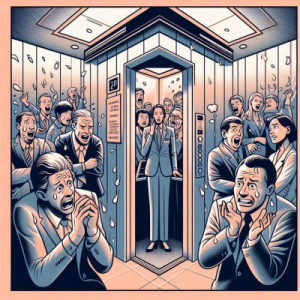You might be surprised to learn that phobias can be intricately linked to specific situations, often impacting your daily life more than you realize. For instance, imagine standing in front of a crowd, your heart racing as the fear of judgment takes over, or feeling confined in an elevator, where the walls seem to close in on you. These situations can trigger intense reactions that many people face but seldom discuss. Curious about how these phobias manifest and affect individuals like you? Let’s explore five notable examples that highlight this fascinating connection.
Fear of Public Speaking
 Many people frequently experience a profound fear of public speaking, often referred to as glossophobia. This fear can manifest as intense stage fright or performance anxiety, creating a significant barrier to effective communication. You might find yourself feeling your heart race, palms sweat, and thoughts scatter as you approach the podium.
Many people frequently experience a profound fear of public speaking, often referred to as glossophobia. This fear can manifest as intense stage fright or performance anxiety, creating a significant barrier to effective communication. You might find yourself feeling your heart race, palms sweat, and thoughts scatter as you approach the podium.
Research indicates that this anxiety stems from a deep-seated fear of judgment and social evaluation, making the task feel overwhelming. You’re not alone in this struggle; studies suggest that up to 75% of individuals experience some level of anxiety when speaking in front of others.
The physiological responses tied to stage fright—like increased heart rate and heightened adrenaline levels—are your body’s natural fight-or-flight reaction. Understanding this response can help you reframe your feelings. Instead of viewing your anxiety as a weakness, consider it a natural response to a perceived threat.
To combat performance anxiety, techniques such as deep breathing, visualization, and practice can be incredibly effective. You might find that rehearsing your speech multiple times in a supportive environment helps diminish your fears.
Additionally, focusing on your message rather than your audience can shift your mindset, allowing you to connect with listeners on a deeper level. By addressing these fears directly, you can transform your relationship with public speaking, turning what was once a source of dread into an opportunity for growth and self-expression.
Social Anxiety in Crowds
Crowd anxiety can be an overwhelming experience, often leaving individuals feeling trapped in a sea of unfamiliar faces. When you find yourself in crowded places, your heart may race, palms may sweat, and an intense sense of dread can wash over you. This reaction often stems from a fear of group interactions, where the unpredictability of social dynamics heightens feelings of vulnerability and isolation.
Research indicates that social anxiety in crowds is linked to a deep-rooted concern about being judged or evaluated by others, amplifying your discomfort. In crowded settings, the sheer number of people can trigger a fight-or-flight response. You might feel scrutinized or fear that you’ll embarrass yourself, leading to avoidance behaviors that reinforce the anxiety.
This fear isn’t unfounded; studies show that individuals with social anxiety often have a heightened sensitivity to social cues, making it difficult to navigate group interactions without feeling overwhelmed. Coping strategies can greatly help you manage this anxiety. Gradual exposure to crowded places can desensitize your fear, allowing you to build confidence over time.
Mindfulness techniques, like focused breathing, can help ground you in the moment, reducing feelings of panic. Understanding that others share similar experiences can also foster a sense of connection, reminding you that you’re not alone in this struggle. By addressing your anxiety proactively, you can reclaim your sense of agency in social settings, transforming crowded places into manageable environments for group interactions.
Driving Anxiety
While social anxiety in crowds can be debilitating, another prevalent form of anxiety emerges when you get behind the wheel: driving anxiety. This condition can manifest as an overwhelming fear of driving, often triggered by specific situations such as busy traffic jams or aggressive drivers. You might find yourself sweating, shaking, or even avoiding driving altogether, which can greatly impact your daily life.
Research shows that driving anxiety often stems from a combination of personal experiences and environmental factors. For instance, witnessing or being involved in a car accident can leave lasting psychological scars. Additionally, the stress of maneuvering heavy traffic or the fear of road rage can exacerbate these feelings, making you feel vulnerable behind the wheel.
It’s essential to recognize that you’re not alone in feeling this way. Many individuals experience similar fears, and acknowledging your driving anxiety is the first step toward overcoming it.
Cognitive-behavioral therapy (CBT) has proven effective in treating driving anxiety by helping you reframe negative thoughts and develop coping strategies. Gradual exposure to driving situations, such as practicing in less congested areas, can also help reduce anxiety over time.
Understanding the root causes of your driving anxiety and its triggers empowers you to confront and manage it. With the right support and strategies, you can regain control and enjoy the freedom that comes with driving, transforming your experience from one of fear to one of confidence.
Fear of Flying
Experiencing the rush of anxiety as a plane takes off is a common yet challenging struggle for those with a fear of flying. This condition, known as aviophobia, manifests through various symptoms, including increased heart rate, sweating, and feelings of dread. You might find yourself overwhelmed by thoughts of turbulence or emergency situations, leading to a heightened sense of panic as the plane ascends.
Research shows that understanding your aviophobia symptoms can be the first step toward managing your fear. Recognizing what’s happening in your body allows you to develop effective coping strategies. For instance, deep breathing exercises can help calm your nerves. By focusing on your breath, you can ground yourself and divert attention from distressing thoughts.
Visualizing a successful flight can also serve as a powerful tool. Picture yourself enjoying the journey, perhaps engaging in a book or listening to soothing music. Creating a positive mental image can greatly mitigate anxiety.
Moreover, seeking support can be invaluable. Talking to friends or joining support groups can help you realize that you’re not alone in this experience. Additionally, consulting a mental health professional who specializes in phobias can provide tailored strategies to confront your fear.
Ultimately, while the fear of flying can feel overwhelming, it’s important to remember that with the right coping strategies and support, you can reclaim your ability to travel and experience the world from new heights.
Claustrophobia in Elevators
When stepping into an elevator, the confined space can trigger intense feelings of anxiety for those with claustrophobia. You might feel your heartbeat quicken, your palms become sweaty, and a sense of dread wash over you. This reaction is rooted in a fear of being trapped, which can lead to panic attacks—sudden, overwhelming episodes of fear that are often accompanied by physical symptoms like chest pain and shortness of breath.
Research indicates that about 5-7% of the population experiences claustrophobia, with elevators frequently cited as a triggering environment. Understanding this fear is essential for both individuals and those around them. While modern elevators are designed with safety features, such as emergency brakes and communication systems, the perception of safety doesn’t always translate to comfort for someone facing claustrophobia.
To manage these panic-inducing moments, some strategies can be helpful. Practicing deep breathing techniques before entering the elevator can help calm your nervous system. Visualizing a positive outcome or focusing on your destination might also ease your mind. Additionally, familiarizing yourself with the elevator’s safety features can provide a sense of control, reducing anxiety.
Ultimately, if you find that claustrophobia greatly impacts your daily life, seeking out therapy or counseling can be beneficial. Cognitive-behavioral therapy, in particular, has shown promise in helping individuals confront and manage their fears effectively. By acknowledging your feelings and taking proactive steps, you can reclaim your comfort in elevators.
Conclusion
Understanding phobias can help you navigate your fears more effectively. Did you know that approximately 75% of the population experiences some level of anxiety about public speaking? This statistic highlights how common these fears are, making it essential to address them. Whether it’s the dread of flying or the panic in crowded spaces, recognizing these triggers is the first step toward managing your responses. With the right strategies, you can reclaim control over your life and well-being.





